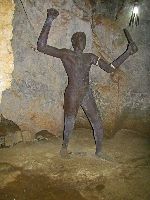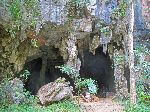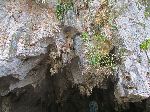| . | ||
Pinar
del Rio
|
||
Valle Acton |
||
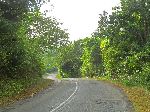 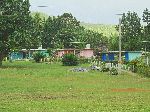
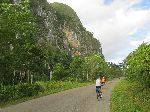
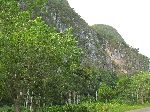
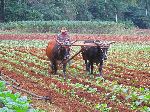 |
||
|
The Cimarron, or Maroon, were Africans who escaped from their enslavement on Caribbean Islands and in South America. After escaping they formed independent settlements. The term is also applied to their descendants. In Cuba, escaped slaves joined up with internal refugee from the indigenous Taínos ethnic group. There were Cimarron communities in the Sierra de los Órganos -- the hills in this area. In their new communities, they tended to follow the lifestyle, culture and religion that they had learn growing up in Africa. |
||
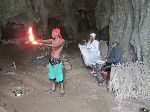 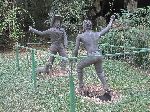 Unfortunately
the
Cimarron Cave does not do the topic justice. The front of the cave is a
large bar with a stage for entertainment. Then there is a passageway through
the limestone rock with a couple of sculpture. The limestone formations are
very modest. As the passageway emerges a couple hundred meters along the
hill, an ensemble puts on a
performance of music, dance and fire handling that last only a couple
minutes - it was very brief and had very little context.. It is suppose to be set in a Cimarron living area. There is another
sculpture of an overload fighting a slave and a large area that is suppose
to replicate an Africa village, that has a dozen roofed open air patios that
is used to serve meals to tourist coming through on bus tours. The "African
houses" in the complex are decorated with scenes that are suppose to depict
aspects of Santeria, the Afro-Cuban religion. Unfortunately
the
Cimarron Cave does not do the topic justice. The front of the cave is a
large bar with a stage for entertainment. Then there is a passageway through
the limestone rock with a couple of sculpture. The limestone formations are
very modest. As the passageway emerges a couple hundred meters along the
hill, an ensemble puts on a
performance of music, dance and fire handling that last only a couple
minutes - it was very brief and had very little context.. It is suppose to be set in a Cimarron living area. There is another
sculpture of an overload fighting a slave and a large area that is suppose
to replicate an Africa village, that has a dozen roofed open air patios that
is used to serve meals to tourist coming through on bus tours. The "African
houses" in the complex are decorated with scenes that are suppose to depict
aspects of Santeria, the Afro-Cuban religion. |
||
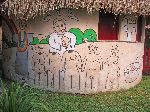
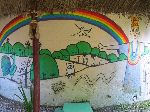
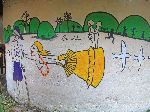
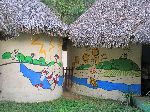
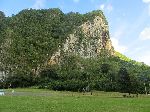 |
||
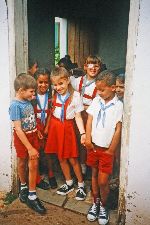 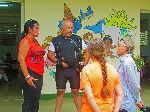 Schools:
My strongest impression of school visits is they have some of the character a
good religious school; clean, orderly, well dressed uniformed students, excellent
discipline and the dominate wall graphics were the icons of the "religion."
Education is mandatory for twelve years. In the upper grades the are multiple tracks, some
academic and some vocational. The students at the grade 1-6 school that we visited were
quiet, curious, neat, clean, relaxed and smiling. The books we saw being used covered
challenging material for the Schools:
My strongest impression of school visits is they have some of the character a
good religious school; clean, orderly, well dressed uniformed students, excellent
discipline and the dominate wall graphics were the icons of the "religion."
Education is mandatory for twelve years. In the upper grades the are multiple tracks, some
academic and some vocational. The students at the grade 1-6 school that we visited were
quiet, curious, neat, clean, relaxed and smiling. The books we saw being used covered
challenging material for the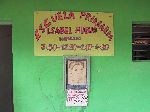 respective grade levels. Cuba’s literacy rate is said to
be 97%. Though there was very little politics in our program and discussion at the school,
the school administrator felt that the U.S. economic embargo is having a negative affect
on their ability to provide a better quality of education. As our first in depth look at
one of the priorities of the revolution it was impressive. These are some of the first of a half
dozen schools in the province the program has visited. We would leave note books, calculators, pens and
pencils, paper and other school supplies. respective grade levels. Cuba’s literacy rate is said to
be 97%. Though there was very little politics in our program and discussion at the school,
the school administrator felt that the U.S. economic embargo is having a negative affect
on their ability to provide a better quality of education. As our first in depth look at
one of the priorities of the revolution it was impressive. These are some of the first of a half
dozen schools in the province the program has visited. We would leave note books, calculators, pens and
pencils, paper and other school supplies. |
||
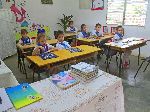
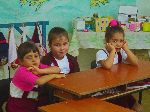
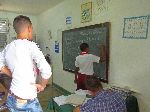
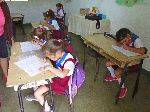
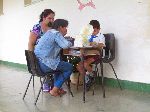 |
||
| The visits to
schools are opportunities; to meet staff and students, observe education,
teaching aids and educational materials, school organization, instruction
schedule, class size, instruction in specialty subjects, allocation of
resources in rural areas where schools have one or two teachers, low
enrollment and multiple grades, observation the evaluation, testing and
development of instruction plans for students with special needs, etc. Interesting discussions in conjunction with this the post-revolution national literary program. Literate people from urban areas were trained to teach literacy in rural areas. The teachers would live with rural families, often in conditions much more basic than they were used to in cities. After literacy program had made significant nation-wide gains, a concerted expansion and improvements of the primary schools was added to the agenda. Eventually this was followed by new policies in post primary education programs included free university education was initiated. |
||
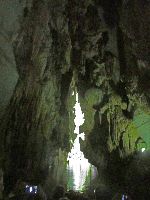
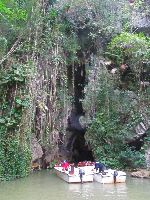
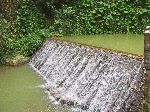 Cueva
Indio: The Cordillera de Guaniguanico (mountains) are largely
limestone and filled with caves. The Indian Caves are unique because after
walking a few hundred meters into the cave you come to a subterranean river. There you
board a motor boat, motor up river a bit and then back down river until you motor right
out of the cave. Oh, and into a market of curio sellers. Once on the boat it
is hard to
hear the explanations over the sound of the motor and the boat never lingered,
even in front of the most impressive formations, so it was
more like a tourist trap than an geological tour. While spacious, it doesn't
have the great stalactites, stalagmites, and column of some limestone caves. Cueva
Indio: The Cordillera de Guaniguanico (mountains) are largely
limestone and filled with caves. The Indian Caves are unique because after
walking a few hundred meters into the cave you come to a subterranean river. There you
board a motor boat, motor up river a bit and then back down river until you motor right
out of the cave. Oh, and into a market of curio sellers. Once on the boat it
is hard to
hear the explanations over the sound of the motor and the boat never lingered,
even in front of the most impressive formations, so it was
more like a tourist trap than an geological tour. While spacious, it doesn't
have the great stalactites, stalagmites, and column of some limestone caves.The water course is natural, but the secret to the boat-able subterranean river is a manmade dam just outside the cave. |
||
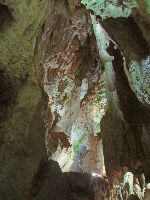
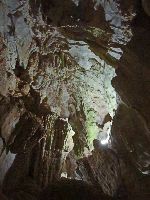
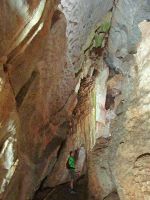
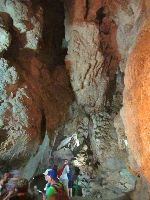
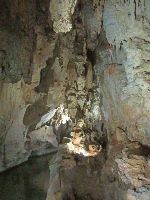 |
||
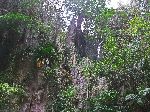
The rock formations outside of the cave can be as interesting as those inside. If you can see past the vegetation it is a hodge-podge of spires, ledges and gully, faced with formation of solidified limestone. One analogies would be a mass of partially melted candles. |
||
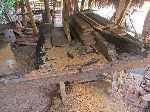
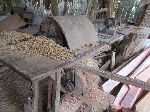
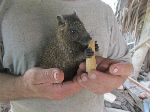 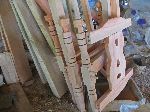 Cuban
towns and villages still have a smattering of traditional crafts people. If you
pass through too quickly you are likely to miss them. This woodworker's
shop had equipment that the average urban dweller is unlikely to have seen.
Stack around were the products of the plains and lathes. Cuban
towns and villages still have a smattering of traditional crafts people. If you
pass through too quickly you are likely to miss them. This woodworker's
shop had equipment that the average urban dweller is unlikely to have seen.
Stack around were the products of the plains and lathes.Also on-site was the woodworker's pet hutia, a moderately large cavy-like rodent. Out of its cage, and without a distraction, it was hyper-active. With some food to gnaw on it was very calm and docile. |
||
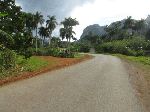
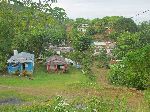
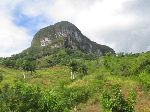
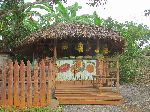
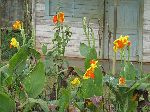 |
||
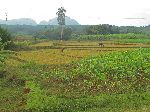 Beyond
Valle Acton, the continues on towards
La Palma. It offers the best of rural Cuba: a road in good condition with
almost no traffic, a interesting and esthetic mix of scenery, including
forests, villages, small towns, scenic vistas, gardens, a mixture of
agriculture (the biggest acreage is malanga and rice), a variety of human
activity. Beyond
Valle Acton, the continues on towards
La Palma. It offers the best of rural Cuba: a road in good condition with
almost no traffic, a interesting and esthetic mix of scenery, including
forests, villages, small towns, scenic vistas, gardens, a mixture of
agriculture (the biggest acreage is malanga and rice), a variety of human
activity. |
||
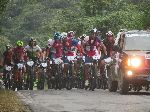
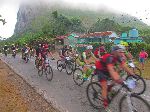 The
serendipitous is sometime the most amusing. On one visit, for several days
we crossed paths with a 5-day mountain bike stage race. It wandered around
both paved and dirt roads in Pinar del Rio Province. The race was sponsored
by a Spanish organization. Of the 150 or so riders, more than two-thirds
were Spanish, about ten percent were Cuban, and the others were from other
countries in Europe, North America, and South America. The event ended at
the beach. The
serendipitous is sometime the most amusing. On one visit, for several days
we crossed paths with a 5-day mountain bike stage race. It wandered around
both paved and dirt roads in Pinar del Rio Province. The race was sponsored
by a Spanish organization. Of the 150 or so riders, more than two-thirds
were Spanish, about ten percent were Cuban, and the others were from other
countries in Europe, North America, and South America. The event ended at
the beach. |
||
|
|
||
    |
||
|
"Hosted by
DreamHost - earth friendly web hosting"
|
||
|
|
|
